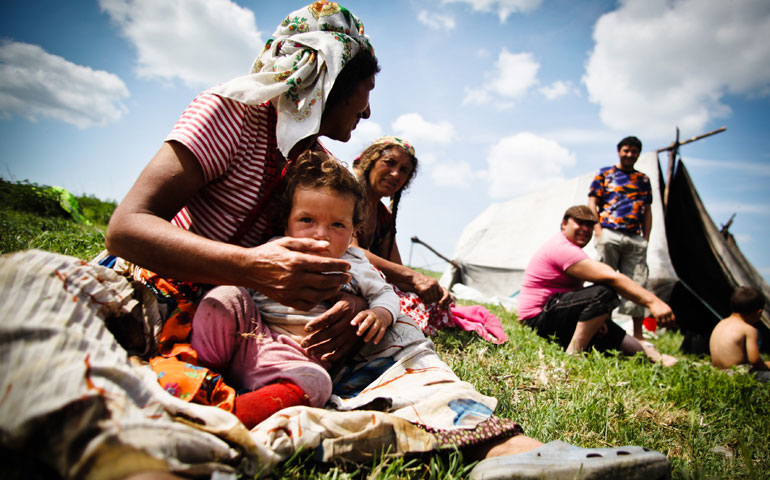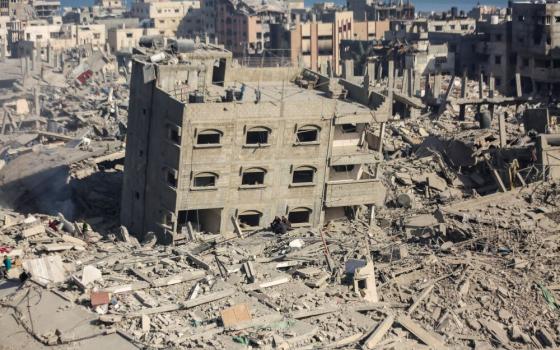
A Roma family in a Gypsy camp rests in Valea Stanii, Romania, in May 2012. (CNS/EPA/Mihai Barbu)
In a corner of eastern Slovakia, a middle-aged nun steps from a bus in the spring sunlight and heads across the gravel yard past a row of crumbling tenements, as the bell from the nearby church summons local residents to morning Mass.
When Sr. Atanazia Holubova joined the Greek Catholic Order of Basil the Great in the early 1970s, her country was under communist rule and religious orders were banned. She was also highly unusual, as one of very few would-be nuns from Eastern Europe's large Roma, or Gypsy, minority.
More than four decades after completing her Basilian novitiate in secret while working as a hospital nurse, she's helped build a school and culture center for her fellow Roma at Bardejov, Slovakia, and provided much-needed pastoral care for poor Gypsy families.
While conditions have improved in some areas, however, they've remained much the same in others.
"It's hard to generalize -- we're still working and making small steps, but life is hard here," Holubova told NCR. "There are a few priests and nuns from the Roma community now, and some seminarians in training. But spiritual conditions reflect the economic situation, and most Roma settlements are still just as poor and downtrodden as ever."
Gypsies reached Europe from India in the Middle Ages after fleeing Islamic invaders, and are known by various group names, the commonest being Roma and Sinti.
They were hunted as outlaws in some countries during the 17th and 18th centuries. In World War II, up to half of all Roma were killed by the Nazis in the Porraijmos, or Roma Holocaust, an atrocity not officially commemorated until the 1990s.
Today, Europe's 10 million Roma still comprise a third of the world's total. But they remain the continent's least organized and represented minority, with high infant mortality, unemployment averaging 80 percent, and life expectancy at 15 years below the average.
In April, the Council of European Bishops' Conferences marked International Roma Day by deploring the Roma's continued mistreatment and urging Christians to do more to ease their plight.
"Roma are among the most deprived and marginalized people, facing daily discrimination and often denied access to basic schooling, housing and health care," the Swiss-based council said in a joint statement with the non-Catholic Conference of European Churches. "The Roma have a centuries-old sense of shared European identity and free movement across political, cultural, and religious boundaries. They are one of the indigenous European nations, however, without an equal standing in terms of respect and honor among them. More than 600 years after their migration to Europe, their full reception remains incomplete."
However, some observers fear the attention of governments and institutions is now diverted by the refugee crisis, consuming resources that might otherwise have been available to Europe's Roma.
"Some Roma communities look similar to the segregated camps occupied by refugees from Iraq and Syria, with no identity cards or decent facilities," said Thierry Bonaventura, spokesman for the Council of European Bishops' Conferences. "Although Roma problems are still acute everywhere, media interest has moved away, while the politicians are preoccupied elsewhere. Many Europeans still have trouble considering Roma as real citizens. Even in the churches, we need a great cultural effort to help people understand who they are."
Both the European Union and United Nations have criticized European states for denying equal rights to Gypsies, while human rights organizations have condemned their forced eviction from unofficial settlements, including the bidonvilles, or shantytowns, of France, and warned that anti-Roma declarations by right-wing politicians could fuel violent attacks.
The European Roma and Travellers Forum, set up in 2004 under guidance of the Council of Europe with elected delegates from some 40 countries, has also issued regular reports, documenting "discrimination, aggression, intimidation, eviction, deportation and hate speech" in countries such as Bulgaria, Romania, Sweden and France.
In a "Charter on the Rights of the Roma," adopted in 2009, the forum noted how Roma had been deprived of recognition as a national minority and "treated as a social fringe group" with "disciplinary measures and state repression."
It also deplored how the fate of Roma had been "determined by self-appointed experts and specialists," leaving them to be viewed by much of society, with government and media encouragement, as "a criminal and unwanted menace."
While many Roma belong to charismatic and Pentecostalist sects, which began actively recruiting them in the 1960s, many are also devout Catholics. Yet Europe's Catholic church has been slow in responding to their needs.
In 1965, the Vatican hosted the first Gypsy pilgrimage and recognized a pastoral mission at the initiative of local Catholic clergy, while Pope Paul VI visited a Roma settlement near Rome.
However, it took until 2006 for a pontifical council to issue the church's first "Guidelines for the Pastoral Care of Gypsies," and until 2007 to organize the first World Meeting of Gypsy Priests, Deacons and Religious Men and Women, with 40 participants.
Over the past two years, Pope Francis has shown a lead. In June 2014, he addressed a five-day Vatican pastoral conference, hitting out at anti-Roma prejudice and suspicion, and calling on Europe's governments to help integrate those "at the margins of society."
He also recalled the scorn for Gypsies he'd personally encountered on Rome buses and deplored how Roma were still often driven toward "new forms of slavery," such as forced begging.
Last October, Francis returned to the theme, greeting 7,000 Roma pilgrims in the Vatican's Paul VI Hall.
"The time has come to uproot secular prejudice, preconceived ideas and the reciprocal diffidence that are often at the base of discrimination, racism and xenophobia," he said. "No one must feel isolated … and no one is entitled to trample on the dignity and the rights of others."
Catholic leaders have responded by urging the EU to improve Gypsy access to education, health care, employment and housing, while calling for European schoolchildren to be given classes in Roma culture and history.
Meanwhile, several bishops' conferences have set up Roma missions and pastorates, including those of the Czech Republic and Poland. The Polish church also organizes an annual Gypsy pilgrimage to the southern Marian shrine of Limanowa.
In Hungary, where Roma make up 7 percent of the 10-million-strong population, the church is running special social and educational facilities. Yet here, too, Catholic leaders have been urged to do more.
"The current political system is doing too little to counter the marginalization of Roma," Bishop Miklos Beer of Vac, Hungary, told the Austrian Broadcasting Corporation in January.
He warned that most Roma remain, even today, "foreigners in their own country," at a time when public attention was focused on refugees and asylum-seekers, and said aid efforts were being hampered by the "self-righteousness of the successful."
"As long as there are poor and disadvantaged among us, it's an illusion to think we're secure," Beer added, "and to relax in our comfortable apartments, smart cars and holiday homes."
It was at Hungary's primatial see of Esztergom that an unofficial International Catholic Committee for Gypsies gathered in April, attended by 140 priests, nuns and lay Catholics specializing in Roma pastoral work.
In their joint declaration the same month, the Council of European Bishops' Conferences and the Conference of European Churches recalled the "long history" of anti-Gypsy prejudice, noting how Roma minorities have nevertheless preserved their culture, and should be brought into a "meaningful dialogue" that respects their identity.
The two groups urged Europe's Christians to acknowledge their own historical responsibility for forms of mistreatment that were "a disgrace to all European countries," and to recognize how Roma, "with their unique traditions, faith and culture," could "bring values to European society as responsible citizens."
"For centuries, Roma have been enslaved, tortured and murdered, their families broken apart -- they suffered legal persecution, were segregated from society and denied basic civil rights," the two church organizations added. "Their inclusion now is a necessary indication of our commitment to a shared European identity, and to the free movement of people, commerce and ideas."
Bonaventura, the Council of European Bishops' Conferences spokesman, welcomes the unity being shown by all churches on Roma issues. However, with material conditions still varying widely around the 28 countries of the EU, he agrees the hardships and injustices facing Roma are a long way from being resolved.
Catholics like him hope Francis will continue defending the cause of the Roma and recall their historic mistreatment this June when he visits the former Nazi-run Auschwitz-Birkenau concentration camp, where more than 20,000 Gypsies were killed.
"While steps have been taken to help the Roma, the truth is that not much has really changed in their situation -- while many of their problems have now been overshadowed by the more general economic crisis," Bonaventura told NCR. "Much more needs to be done to highlight best practices which have had some impact, while efforts continue to change the cultural conditions which have so greatly worked against them."
Back in Slovakia, Sr. Atanazia Holubova, now 63, recently retired from her teaching work after preparing hundreds of local Roma children over the years for first Communion. But she remains a familiar figure among Bardejov's 1,600-strong Roma community, while also sitting on the Slovak church's Roma pastoral council and helping organize Gypsy pilgrimages to the sanctuaries of Gaboltov and Lutina.
Some three dozen Roma priests and nuns are now at work in the Catholic church across Europe, including nine in Slovakia. In 1997, thousands of Gypsy Catholics attended the beatification of a Roma, Ceferino Giménez Malla (1861-1936), martyred during the Spanish Civil War.
Holubova returned to Rome for the anniversary of Ceferino's martyrdom in June 2011, and was shown in the world's media being personally greeted by Pope Benedict XVI. Yet she admits the problems are vast.
Although the EU unveiled a strategy five years ago to ensure the social integration of Roma by 2020, she says, local administrators often divert funds intended for Gypsies to other uses, while Roma social and cultural facilities are crowded and overused.
While Gypsies could become the majority in Slovakia by 2050, according to some forecasts, most young Roma still drop out of school and remain isolated from the majority population, and the country still has just a single Roma minister of parliament.
"For most Roma communities, the prospects will depend on individuals with will and energy -- and the possibilities they create by finding opportunities for themselves and others," Holubova told NCR.
"But no one really wants to help, and there's been no significant change in public attitudes. This is why the church's pastoral care can't be confined to conducting services, but has to broaden out to other areas as well."
[Jonathan Luxmoore's two-volume study of communist-era persecution, The God of the Gulag, has just been published by Gracewing in the U.K.]








